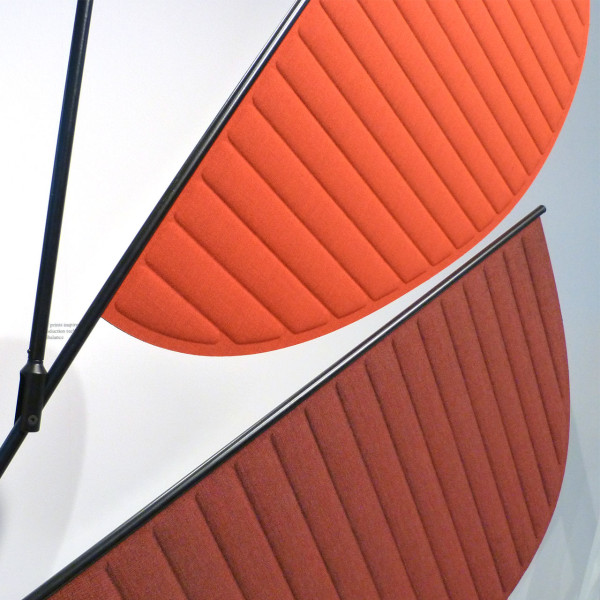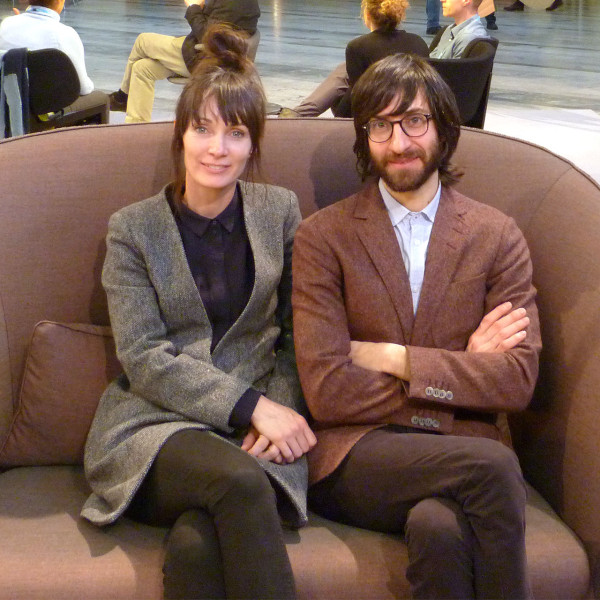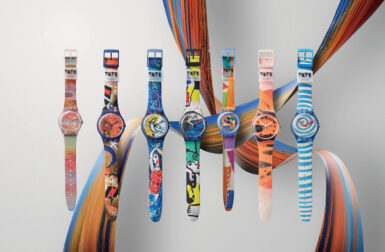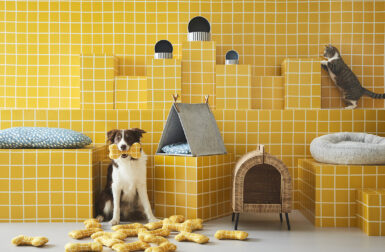Guests of honor at this year’s Stockholm Furniture Fair were Danish architect Stine Gam and Italian architect Enrico Fratesi, aka GamFratesi. I was honored to interview them within the installation they created for the show…
Are you enjoying the show?
Enrico: Now is the best moment. It has been quite challenging. We had a long time to make everything and we wanted to make an installation, but in a way, we are quite connected to products, so [we felt] the installation should be in some way a product. To make this possible we needed tooling, and testing different solutions. The balance part is also very tricky, because every time you change a little something, everything else wouldn’t work, so we had to do it again, and again, and again. That was part of the project and part of the idea, but it was making everything complicated. So over the next couple of days, we can actually enjoy it. You never know until the end if it’s actually going to work!
What’s the most important thing to know about you as designers?
E: I think we make products which combine quality, intimacy and communication – we like to bring these three parts together. We focus on quality, because we need to make products that will have a long life. I think you can feel that our products have that quality – when you use them, you can really enjoy that. Intimacy has always been a key part of our work as well – we try to find these small spaces where you can suggest intimacy, reflection… Sometimes it’s a sofa, sometimes it’s a desk, sometimes it’s a chair, but you will always be embraced, so you have a relationship with the product. And communication between the product and the user is always important as a feature, because if you get into communication with a product you start to love it, you’re more likely to keep it and if you keep it for a long time, it becomes more sustainable. We never think of a product by itself, we always think of a product in a context with people. A product by itself doesn’t make any sense – it’s a sculpture.
Your work seems very Scandinavian to me – is it more Danish or more Italian?
E: Of course the combination of material, of functionality, is very connected to being Scandinavian. We live in Copenhagen and many of our clients are Scandinavian. The Italian approach is more about the concept and every time we have a project, there is always a very strong concept or ideology behind it. That’s probably the intellectual part, but the execution is perhaps more Danish. If you look at some of the classic Danish chairs from the masters, they don’t even have a name, they have a code, it’s all about function and material – they’re extremely functional. Whereas, every time we have a strong concept and that’s why it’s interesting. It Italy it’s more important to have an innovation of the product or the concept, than the function. So although they look more Danish, the whole is a combination of the two.
How did it feel to be recognized with Elle Decoration Young Design Talent 2013?
E: It was completely unexpected. We knew nothing about it until it happened. It was extremely important to us. There are 25 Elle Decorations in the world, and it was an international award, so for them to agree on us, it was like “Wow – thank you!”
And how about being chosen at the Stockholm Furniture Fair Guest of Honor?
Stine: That was a surprise as well. We weren’t expecting it at all – we just got an invitation, so it was a very big surprise.
What are you most proud of?
E: We love all the products that are in production. We achieve a very good aesthetic and the quality is high – we believe you can feel that in the product. If we’re not satisfied with a product, it’s not in production. In the beginning we understood immediately, that if you’re not happy with the production it’s better to stop in the middle. It’s happened many times with products we’ve had in development that just weren’t going in the right direction, so we’ve decided to quit. It can be difficult to make that decision after you invested time and effort and money into something, but if you think that it would stay around for ever and you don’t like it, that would be worse. In that case, it’s better to say that we tried and it didn’t work, so we stopped it. Sometimes it can be brutal, but it’s better.
What advice would you give to an aspiring designer?
S: You need to have a lot of passion. It’s hard work and you often work in isolation, so you really need to want it. And of course to be curious – it’s important to go to these types of shows and come out of your isolation and you grow and see people’s reactions to your work. To have both critics and comments is important for growing and for learning.
Are there other ways to break out of that isolation in between big shows? Where do you go for inspiration?
E: We are lucky that we are a couple, so we can share everything. If you’re alone, I’ve never been a designer alone, but I guess it’s very difficult, because it’s sharing that helps a lot and if you share in a nice way you can really grow and develop a lot of things. So I think it is extremely interesting the way that a couple like us and a relationship like ours can bring everything to another level. You can share it [if you work alone] of course, but when you’re working on something, it is difficult to share it in the middle of a project, in a way it’s intimate, it’s not finished yet, so it must be kind of tricky.
I’ve noticed more ‘design duos’ in Scandinavia than in Britain – do you think that is a Scandinavian thing?
S: At school we always work in groups…
E:… whereas in Italy, you are more alone for projects, so perhaps it’s difficult after that to make the relationship in a working environment.
How does your design process work, from initial inspiration to final product?
E: Everything starts with talking – we begin by talking a lot, so we talk, talk talk, then when we’re done talking, we draw – sketching and sketching, and then we start modelling. Once we’ve got a model, we go into 3D [CAD drawings], which is really at the end. Sometimes we don’t even go through 3D, we have a physical prototype which we have to scan to create the tools.
S: It depends on the projects – some of our projects are more crafted, so they really have to be made by hand. But even if things need to be more technical, we tend to have the physical process alongside. It’s so important that the details are precise, so we want to think through every detail before we brief the manufacturer, so it doesn’t become a compromise later on. We always do prototypes so we discover anything that might become a problem or a challenge further down the line.
Do you work on everything together, or is there a point at which you divide and conquer?
E: We are mostly together, because we have this relationship in work and in daily life, so it is difficult to divide. We have different backgrounds and we have different skills, so we well work together.
What are you inspired by? What do you do to overcome creative block?
E: For sure something different from design. Art is a big influence, and sometimes it’s not just the artistic piece but the mood behind it, the thought of the artist. Or even poetry might set the mood for each product. The Haiku sofa was inspired by a Japanese haiku. We might bring something as small as a simple gesture to a product. Even when the product ends up being very industrial, we’ve often been inspired by art, but always something outside design, whilst being aware of the heritage of design.
And finally, what is your favorite color?
S: I don’t know! I couldn’t choose.
E: You know it depends on the mood, maybe I’m close to the red tones.
S: I’m maybe more neutral.
E: Actually what we’re wearing, without even knowing!


























